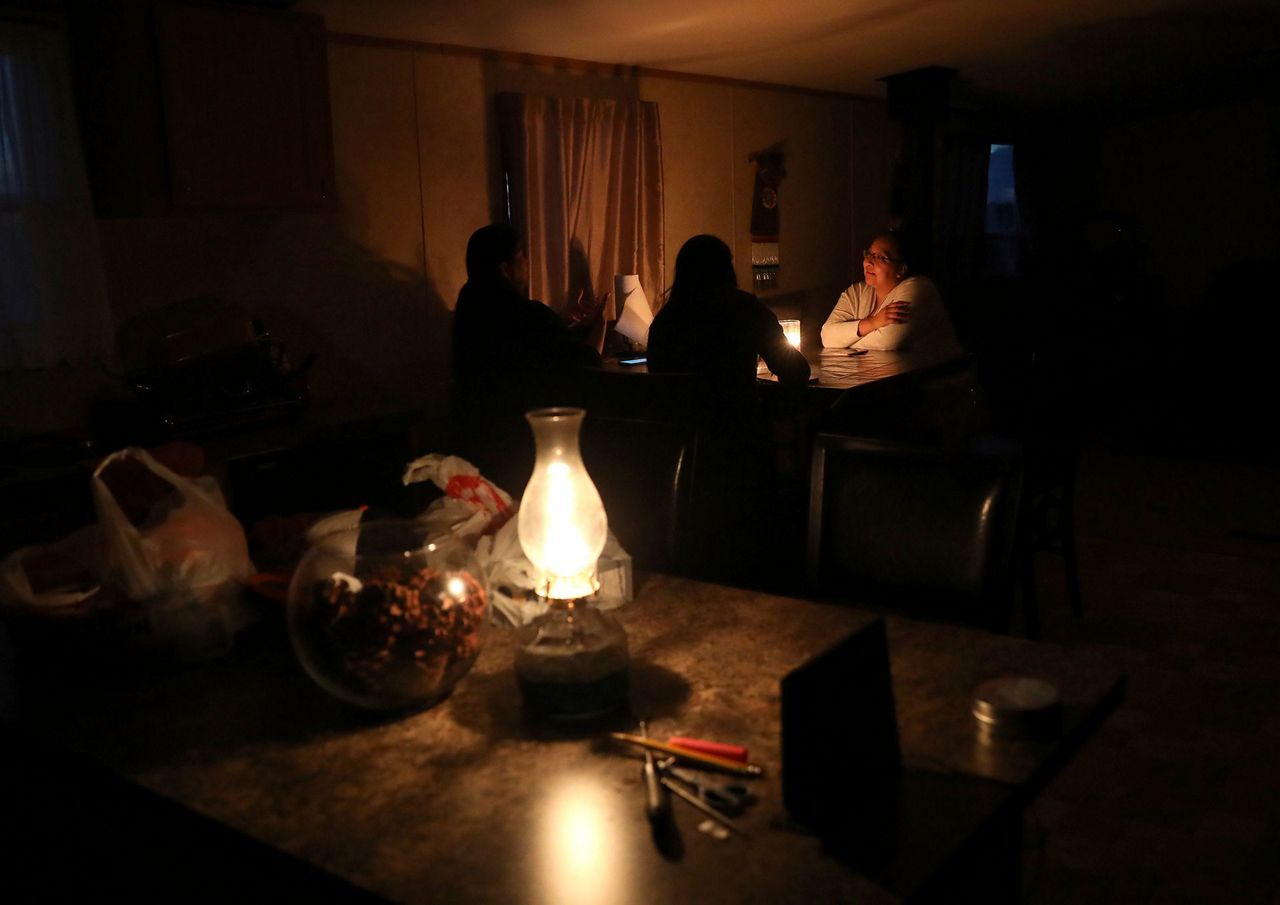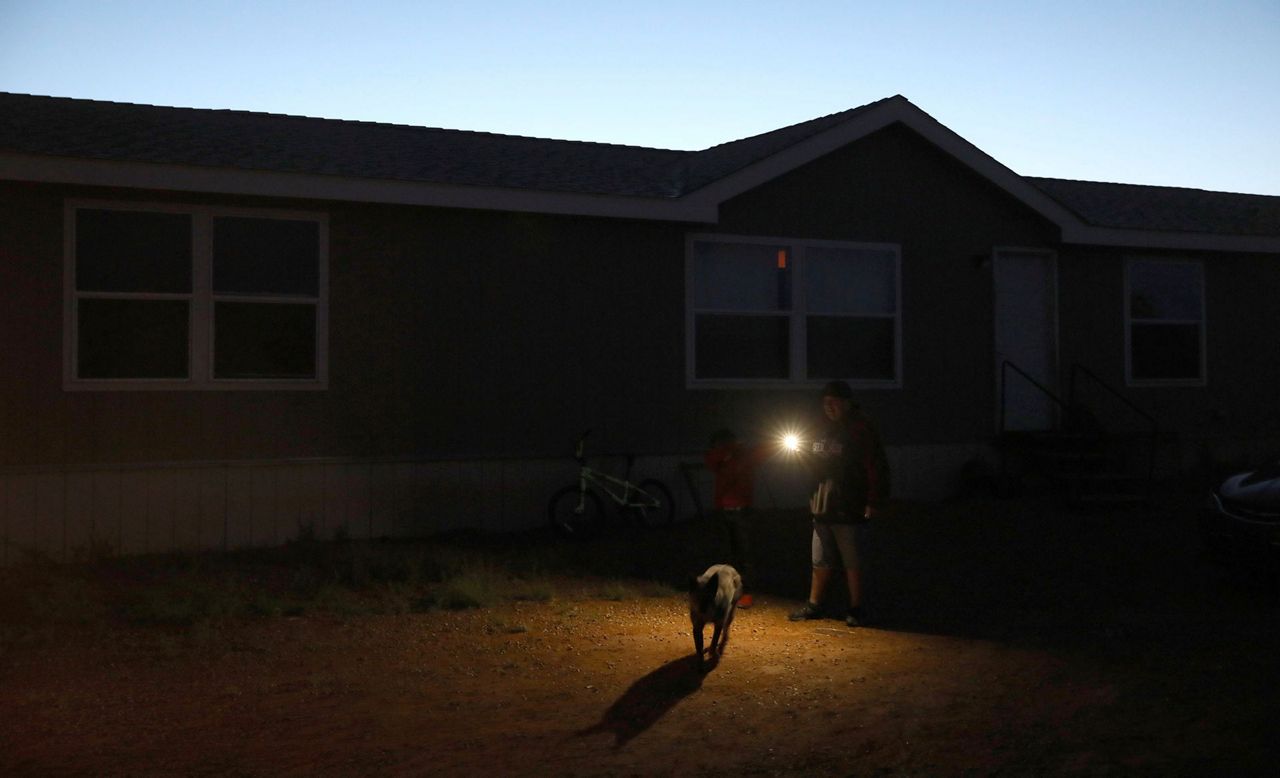KAIBETO, Ariz. (AP) — In a story May 18 about electricity on the Navajo Nation, The Associated Press erroneously reported the name of a senior vice president at the American Public Power Association. He is Mike Hyland, not Mark Hyland.
A corrected version of the story is below:
No longer in the dark: Navajo Nation homes get electricity
No longer in the dark: Navajo Nation homes get electricity one by one as work advances to give power to 60,000 who don't have it
By FELICIA FONSECA
Associated Press
KAIBETO, Ariz. (AP) — Miranda Haskie sits amid the glow of candles at her kitchen table as the sun sinks into a deep blue horizon silhouetting juniper trees and a nearby mesa.
Her husband, Jimmie Long, Jr., fishes for the wick to light a kerosene lamp as the couple and their 13-year-old son prepare to spend a final night without electricity.
They're waiting for morning, when utility workers who recently installed four electric poles outside their double-wide house trailer will connect it to the power grid, meaning they will no longer be among the tens of thousands of people without power on the Navajo Nation, the country's largest American Indian reservation.
Haskie and Long are getting their electricity this month thanks to a project to connect 300 homes with the help of volunteer utility crews from across the U.S.
The Navajo Tribal Utility Authority typically connects from 400 to 450 homes a year, chipping away at the 15,000 scattered, rural homes without power on the 27,000-square-mile (43,000-square-kilometer) reservation that lies in Arizona, New Mexico and Utah.
At that rate, it will take the tribal utility about 35 more years to get electricity to the 60,000 of the reservation's 180,000 residents who don't have it.
The couple's home at the end of rutted dirt roads outside the small town of Kaibeto was about a quarter-mile (0.4 kilometers) from the closest power line. Life disconnected from the grid in the high desert town dotted with canyons and mesas was simple and joyful but also inconvenient, they said.
"It's not that bad. Growing up, you get used to it, being raised like that," Long said.
The family's weekday routine included showering, cooking and charging cellphones, battery packs and flashlights at Haskie's mother's house 2 miles (3.2 kilometers) away, down dirt roads that turn treacherous in stormy weather.
Navajos without electricity also pack food or medication in coolers with ice or leave it outside in the wintertime. Children use dome lights in cars or kerosene lamps to do their homework at night. Some tribal members have small solar systems that deliver intermittent power.
No electricity typically means no running water and a lack of overall economic development. Creating the infrastructure to reach the far-flung homes on the reservation is extremely costly.
Hooking up a single home can cost up to $40,000 on the reservation where the annual, per-capita income is around $10,700 and half the workforce is unemployed, said Walter Haase, general manager of the Navajo Tribal Utility Authority.
For the recent power hookup project called LightUpNavajo, the utility raised funds from an online campaign, collected donations from employees, businesses and communities, and used revenue from solar farms on the reservation to cover the utility's $3 million cost. Money that isn't raised will be borrowed and the repayment passed on to customers via their rates, Haase said. The project started in March and ends this month.
The volunteer crews spent days on the reservation, learning about Navajo culture, the language and the landscape before setting out to job sites often hours away from their hotel rooms. Tribal utility crews had already performed much of the prep work, removing trees or stumps so the volunteers could focus on installing power poles and miles of electric line to connect homes.
A four-man crew from Piqua, Ohio, weathered rain, dust storms and sandy terrain that threatened to bury their equipment as they traveled through the western part of the reservation in Arizona earlier this month. They heard from families who have waited months, years and a lifetime to get power. Navajos showed their appreciation to the crews with feasts of fry bread, steaks and steamed corn.
"It's kind of crazy to think about the different things you take for granted on a daily basis," said Ken Wagner, a journeyman lineman for Piqua Power System. At an appreciation dinner, his crew received gifts of posters with traditional Navajo sayings, turquoise jewelry, shirts and mugs.
Among those getting electricity hookups were Vernon Smith and his wife, Bertha. They live in Salt Lake City but are preparing their home in Tuba City on the reservation for a move back. They became set on getting electricity when a kerosene lamp tipped over while she was napping and she feared the house would burn down.
The wait for electricity took three years, but Vernon Smith called that "a miracle."
"I couldn't believe it," he said in an interview, his face lighting up as recalled seeing the whirling blades of a ceiling fan in his reservation home for the first time. "I didn't think I was going to get electricity that fast."
Haskie said she could live without electricity but that it's also exciting getting it.
"I can walk in, turn the light on without my son turning on the generator," she said.
She's crafted a wish list that includes a blender, a coffee maker, a juice maker, a stand-up mixer and an espresso machine. Eventually, she'll subscribe to cable TV.
The couple's son, Jayden, said he managed fine without power — using portable chargers for his cellphone. Some days, he fired up a gas generator that was hooked up to the home's electric panel to watch TV or turn on the light in his bedroom.
But the generator's 5-gallon (19-liter) tank lasted less than a day and the cost of fuel meant it was used sparingly and mostly on the weekends.
He's looked forward to taking eggs, bacon, steak, pork chops and hamburgers out of a refrigerator to cook whenever he wants.
As of Thursday, the LightUpNavajo project hooked up 208 homes. Crews from 26 utilities in 12 states traveled to the reservation to help, installing 1,500 power line poles and more than 35 miles (56 kilometers) of electric lines.
The project was designed with a $125,000 grant from the American Public Power Association. Mike Hyland, an association senior vice president, said the group and the tribal utility will consider repeating it on the Navajo Nation, or using it as a model for other reservations or rural areas.
On the morning that Haskie's and Long's home got power, journeyman lineman Justin Foutz with the Piqua utility slipped on a pair of gloves and grabbed an extendable, yellow tool to close a switch atop the utility pole and send power to the home.
"Coming in hot," he said.
A few minutes later, electrician Delbert Graham knocked on the trailer's door.
"Hey, you're energized," he said. "Go ahead and turn on your main breaker."
Using a flashlight inside the darkened house, Long flipped on the breaker, turned on the home's porch light and opened the door with a smile.
Then the crew loaded up their utility trucks and headed toward the small community of Coppermine, about an hour's drive down the next dirt road, to connect more homes.
Copyright 2019 The Associated Press. All rights reserved. This material may not be published, broadcast, rewritten or redistributed.














